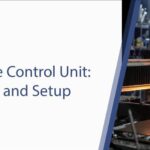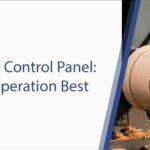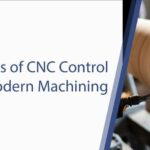CNC (Computer Numerical Control) technology has become an indispensable part of the modern manufacturing world. At the heart of this technology are CNC control boards, which convert commands from a computer into electrical signals that CNC machines can understand, enabling precise control of motors.
These boards are available in various configurations based on the number of axes they support, such as 3-axis, 4-axis, 6-axis, and more. So, which control board with a specific number of axes is best suited for your needs? The answer depends on the complexity of your work, the level of precision required, and your budget.
In this article, we will thoroughly examine the differences between 3-axis, 4-axis, and 6-axis CNC control boards, their advantages and disadvantages, areas of application, and which one might be the most suitable option for you.
What Are CNC Axis Systems?
In CNC machines, axes refer to the directions in which the machine can move. The main axes of a CNC machine are as follows:
- X-Axis: Horizontal movement (left-right)
- Y-Axis: Lateral movement (forward-backward)
- Z-Axis: Vertical movement (up-down)
- A-Axis: Rotational movement around the X-axis
- B-Axis: Rotational movement around the Y-axis
- C-Axis: Rotational movement around the Z-axis
The first three axes (X, Y, Z) provide linear movements, while the other axes (A, B, C) represent rotational movements.
3-Axis CNC Control Boards
Features and Structure
3-axis CNC control boards, as the name suggests, control the X, Y, and Z axes. These boards are typically the most basic and widely used CNC control boards.
Key Features:
- Control of X, Y, and Z axes
- Pulse frequency typically between 100-400 kHz
- USB, parallel port, or Ethernet connectivity
- Limited number of input/output ports
- Compatibility with software like Mach3 and GRBL
Advantages
- Affordable Price: 3-axis control boards are generally more economical compared to boards with a higher number of axes.
- Ease of Installation and Use: With fewer axes and a simpler structure, installation and configuration are relatively easy.
- Wide Software Support: They work seamlessly with popular CNC software like GRBL and Mach3.
- Adequate Performance: They provide sufficient performance for many basic CNC operations.
Ideal Applications
3-axis CNC control boards are particularly preferred in the following areas:
- 2D cutting operations (laser cutting, plasma cutting)
- Simple 3D carving and milling tasks
- PCB prototyping
- Basic woodworking projects
- Hobby CNC machines
Example Model and Technical Specifications
USB CNC 3-Axis Control Board
- Control of 3 axes (X, Y, Z)
- 100 kHz pulse frequency
- USB interface
- Compatible with Mach3
- 5 input ports (for limit switches and emergency stop)
- 1 relay output (for spindle control)
4-Axis CNC Control Boards
Features and Structure
4-axis CNC control boards, in addition to the basic 3 axes (X, Y, Z), can typically control an additional axis, often the A-axis (or C-axis). This additional axis is usually used for a rotary table or a 4th-axis attachment, enabling rotational movement of the workpiece.
Key Features
- Control of X, Y, Z, and A axes
- Pulse frequency typically between 100-500 kHz
- USB, parallel port, or Ethernet connectivity
- More input/output ports
- Advanced software support
Advantages
- More Complex Operations: The 4th axis allows for processing cylindrical parts or creating complex geometries.
- Versatility: Capable of performing both 2D and simple 3D/4D operations.
- Moderate Cost: Slightly more expensive than 3-axis systems but much more economical than 6-axis systems.
- Balanced Performance/Price Ratio: Ideal for many small to medium-sized businesses and hobbyists.
Ideal Applications
4-axis CNC control boards are particularly preferred in the following areas:
- Processing cylindrical parts (lathe operations)
- Woodturning and carving
- Jewelry production
- Small to medium-scale metalworking
- Production of moderately complex parts
Example Model and Technical Specifications
4-Axis USB CNC Control Board (Mach3 Compatible)
- Control of 4 axes (X, Y, Z, A)
- 100 kHz pulse frequency
- USB interface
- Compatible with Windows XP, Vista, Windows 7 (32 or 64-bit)
- 5 input ports
- 1 spindle control output
- MPG handwheel support
6-Axis CNC Control Boards
Features and Structure
6-axis CNC control boards are advanced systems capable of controlling all standard axes (X, Y, Z, A, B, and C). These boards are designed for industrial CNC machines, robotic applications, and processes requiring high precision.
Key Features
- Full control of X, Y, Z, A, B, and C axes
- High pulse frequency (typically above 400 kHz)
- Ethernet, EtherCAT, or other industrial communication protocols
- Numerous input/output ports
- Advanced interpolation and motion control
- Compatibility with professional CNC software
Advantages
- Maximum Flexibility: The 6 axes enable the processing of even the most complex geometries.
- High Precision: Advanced motion control algorithms provide micron-level precision.
- Versatile Production Capability: Ability to perform a wide variety of operations in a single setup.
- Industrial Standards: Built for durability and reliability in industrial environments.
- Advanced Features: Automatic tool changing, multi-workpiece processing, and other high-level features.
Ideal Applications
6-axis CNC control boards are particularly preferred in the following areas:
- Aerospace and defense industry components
- Medical implants and devices
- Complex mold production
- 5-axis milling applications
- Industrial robotic systems
- Production processes requiring high precision
Example Model and Technical Specifications
6-Axis Industrial CNC Control Board
- Control of 6 axes (X, Y, Z, A, B, C)
- 1 MHz pulse frequency
- Ethernet/EtherCAT interface
- 32 digital inputs and 32 digital outputs
- 4 analog inputs and 4 analog outputs
- Real-time control system
- Built-in PLC functions
- Advanced error diagnostics and monitoring
Comparison Between Boards
Performance Comparison
Pulse Frequency and Speed
- 3-Axis Boards: Typically 100-200 kHz
- 4-Axis Boards: Typically 100-400 kHz
- 6-Axis Boards: Typically 400 kHz-1 MHz
Higher pulse frequency means faster and more precise motion control, which is especially important for processing complex curves and surfaces.
Precision
- 3-Axis Boards: Medium precision (0.01-0.05 mm)
- 4-Axis Boards: Good precision (0.005-0.02 mm)
- 6-Axis Boards: High precision (0.001-0.005 mm)
Price Comparison
The prices of control boards vary depending on the number of axes, brand, and features:
- 3-Axis Boards: $20-$100
- 4-Axis Boards: $50-$250
- 6-Axis Boards: $300-$2000
Ease of Use
- 3-Axis Boards: Simple installation and configuration, ideal for beginners
- 4-Axis Boards: Moderate installation and configuration, requires some experience
- 6-Axis Boards: Complex installation and configuration, requires professional knowledge
Which Control Board Is Right for You?
- For Hobbyists: 3-axis control boards are the best option for beginners or hobbyists due to their affordability, ease of use, and suitability for simple projects.
- For Small and Medium-Sized Businesses: 4-axis control boards offer a balanced price/performance ratio and are ideal for a variety of projects, including cylindrical part processing and moderately complex production.
- For Industrial Manufacturers: 6-axis control boards are the most suitable choice for industrial use and high-precision, complex projects.
By considering your needs and budget, you can select the control board with the appropriate number of axes to ensure the success of your CNC projects.
Contact Us:
- E-Mail: info@radonix.com
- Phone: +90 (553) 920 5500








